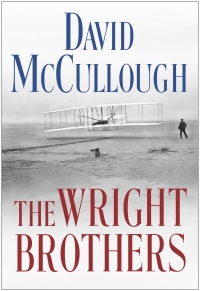
The Wright Brothers, by David McCullough (Simon & Schuster, New York, NY, 2015, 320 pages).
Book Review by Dennis Moore
If I were giving a young man advice as to how he might
succeed in life, I would say to him, pick out a good father
and mother, and begin life in Ohio.
- Wilbur Wright
August 5, 2015 (San Diego’s East County) - David McCullough, 2-time Pulitzer Prize winner, for Truman and John Adams, and 2-time National Book Award winner, for The Path Between the Seas and Mornings on Horseback, as well as the recipient of the Presidential Medal of Freedom, the nation’s highest civilian award, demonstrates in his #1 New York Times Bestseller; The Wright Brothers, why he is deserving of those honors and accolades.
 In this thrilling book master historian McCullough draws on the immense riches of the Wright Papers, including personal diaries, notebooks, and more than a thousand letters from private family correspondence to tell the human side of a profoundly American story. This book is more than just about who is considered “First in Flight”, but more about the humanity behind two industrious brothers and their upbringing which enabled them to change history as we know it.
In this thrilling book master historian McCullough draws on the immense riches of the Wright Papers, including personal diaries, notebooks, and more than a thousand letters from private family correspondence to tell the human side of a profoundly American story. This book is more than just about who is considered “First in Flight”, but more about the humanity behind two industrious brothers and their upbringing which enabled them to change history as we know it.
 This book is also more than about the invention of the airplane, but the pioneering and entrepreneurial acumen and spirit of two young men from Dayton, Ohio, Wilbur and Orville Wright. McCullough details how the brothers would start and build on their “Wright Cycle Company”, or bicycle business, as well as their “West Side News” printing business. The author points out that a high school friend of Orville’s, Paul Laurence Dunbar, who had been the class poet and the only black student in the school, became a contributor to the West Side News. At some point, Dunbar is said to have chalked on the shop wall this quatrain tribute, according to McCullough:
This book is also more than about the invention of the airplane, but the pioneering and entrepreneurial acumen and spirit of two young men from Dayton, Ohio, Wilbur and Orville Wright. McCullough details how the brothers would start and build on their “Wright Cycle Company”, or bicycle business, as well as their “West Side News” printing business. The author points out that a high school friend of Orville’s, Paul Laurence Dunbar, who had been the class poet and the only black student in the school, became a contributor to the West Side News. At some point, Dunbar is said to have chalked on the shop wall this quatrain tribute, according to McCullough:
“Orville Wright is out of sight
In the printing business.
No other mind is half so bright
As his’n is.”
It is interesting to note, that in 1893, through the influence of Bishop Wright, Wilbur and Orville’s father, a first collection of Dunbar’s poems was published by the United Brethren Church, for which Dunbar himself paid the cost of $125. In another few years, according to McCullough’s “The Wright Brothers” book, having been discovered by the editor of The Atlantic Monthly, William Dean Howells, Dunbar had become a nationally acclaimed poet. This book is rich with such anecdotes, which is perhaps why McCullough is considered one of America’s preeminent historians.
Perhaps giving some insight into Wilbur’s perceived reclusive nature, the author details a particular incident in Wilbur’s childhood that had lasting impact on him, and possibly kept him out of Yale. McCullough tells of when Wilbur was in his teens, and was struck in his face by a hockey stick. For weeks he suffered excruciating pain in his face and jaw, then had to be fitted with false teeth. Serious digestive complications followed, then heart palpitations and spells of depression that seemed only to lengthen. The alleged perpetrator of this unfortunate act on Wilbur, whom Wilbur knew well and lived only a few blocks from, would later be executed in Ohio for the murders of his mother, father, and brother, and was believed to have killed as many as a dozen others besides. Except for Bishop Wright’s brief diary mention, made available to McCullough, nothing on the subject is to be found anywhere in the Wright family correspondence or reminiscences. Nor is there much in the way of detail or firsthand description about the devastating after-effect of the accident on Wilbur.
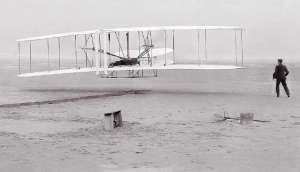 Perhaps most revealing about this book by McCullough, is the foresight demonstrated by Wilbur Wright, in his reaching out to the Smithsonian Institution in a letter dated May 30, 1899, several years before the Wright Brothers famous flight at Kitty Hawk, North Carolina. McCullough describes it as: “Indeed, given all it set in motion, it was one of the most important letters in history.” It set the stage for the controversial to some “Contract (Smithsonian-Wright Agreement of 1948)”, which ostensibly gave the rights to the Wright Brother’s invention of the airplane to the Smithsonian Institution in Washington, D.C. This letter, quoted by the author in his book states:
Perhaps most revealing about this book by McCullough, is the foresight demonstrated by Wilbur Wright, in his reaching out to the Smithsonian Institution in a letter dated May 30, 1899, several years before the Wright Brothers famous flight at Kitty Hawk, North Carolina. McCullough describes it as: “Indeed, given all it set in motion, it was one of the most important letters in history.” It set the stage for the controversial to some “Contract (Smithsonian-Wright Agreement of 1948)”, which ostensibly gave the rights to the Wright Brother’s invention of the airplane to the Smithsonian Institution in Washington, D.C. This letter, quoted by the author in his book states:
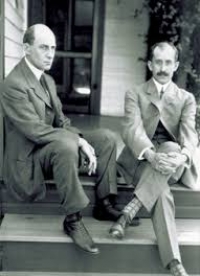 “I have been interested in the problem of mechanical and human flight ever since as a boy I constructed a number of bats of various sizes after the style of Cayley’s and Penaud’s machines,” he began. (Sir George Cayley, a brilliant English baronet and aeronautical pioneer, had also devised a toy helicopter very much like the one by Alphonse Penaud given to the brothers by Bishop Wright.)” Wilbur Wright’s letter to the Smithsonian further went on to state: “My observations since have only convinced me more firmly that human flight is possible and practicable….I am about to begin a systematic study of the subject in preparation for practical work to which I expect to devote what time I can spare from my regular business. I wish to obtain such papers as the Smithsonian Institution has published on this subject, and if possible a list of other works in print in the English language. I am an enthusiast, but not a crank in the sense that I have some pet theories as to the proper construction of a flying machine.”
“I have been interested in the problem of mechanical and human flight ever since as a boy I constructed a number of bats of various sizes after the style of Cayley’s and Penaud’s machines,” he began. (Sir George Cayley, a brilliant English baronet and aeronautical pioneer, had also devised a toy helicopter very much like the one by Alphonse Penaud given to the brothers by Bishop Wright.)” Wilbur Wright’s letter to the Smithsonian further went on to state: “My observations since have only convinced me more firmly that human flight is possible and practicable….I am about to begin a systematic study of the subject in preparation for practical work to which I expect to devote what time I can spare from my regular business. I wish to obtain such papers as the Smithsonian Institution has published on this subject, and if possible a list of other works in print in the English language. I am an enthusiast, but not a crank in the sense that I have some pet theories as to the proper construction of a flying machine.”
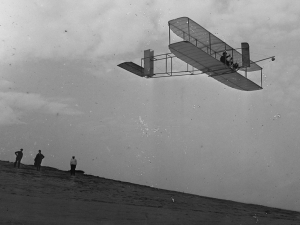 From this initial and possibly presumptive overture on the part of Wilbur Wright, a close connection and arrangement was made with Samuel Pierpont Langley, an eminent astronomer and head, or secretary, of the Smithsonian. It would become quite fortuitous of Wilbur Wright to have written that letter to the Smithsonian Institution, prior to he and his brother Orville having built the flying machine or airplane, and before its first flight at Kitty Hawk in 1903, and now more than 100 years later, that vehicle being housed in the Smithsonian.
From this initial and possibly presumptive overture on the part of Wilbur Wright, a close connection and arrangement was made with Samuel Pierpont Langley, an eminent astronomer and head, or secretary, of the Smithsonian. It would become quite fortuitous of Wilbur Wright to have written that letter to the Smithsonian Institution, prior to he and his brother Orville having built the flying machine or airplane, and before its first flight at Kitty Hawk in 1903, and now more than 100 years later, that vehicle being housed in the Smithsonian.
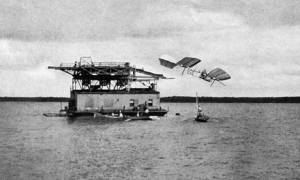 It is ironic, if not suspicious, that just 9 days prior to the Wright Brothers’ famous flight at Kitty Hawk, North Carolina, on December 17, 1903 in their “Wright Flyer”, Samuel Pierpont Langley of the Smithsonian Institution would experience his much ridiculed “aerodrome” being launched from atop a gigantic houseboat and come crashing down into the Potomac River. Making the case that Langley’s failure had been the fault of the launching device for his aerodrome, not for the machine itself, the aerodrome was taken out of storage to be tested again. When tested once more in 1914, according to McCullough’s well researched and documented book, it performed with reasonable success and the Smithsonian endorsed a statement saying, “Professor Samuel P. Langley had actually designed and built the first man-carrying flying machine capable of sustained flight.” It makes one wonder, and considering that Wilbur Wright had reached out to the Smithsonian Institution in 1899 and advised them in his thoughts and intentions, why Langley would attempt the launching of his aerodrome just 9 days before the Wright Brothers’ flight at Kitty Hawk? Could Langley and the Smithsonian have usurped the initial overtures and ideas made by Wilbur in that letter addressed to them in 1899?
It is ironic, if not suspicious, that just 9 days prior to the Wright Brothers’ famous flight at Kitty Hawk, North Carolina, on December 17, 1903 in their “Wright Flyer”, Samuel Pierpont Langley of the Smithsonian Institution would experience his much ridiculed “aerodrome” being launched from atop a gigantic houseboat and come crashing down into the Potomac River. Making the case that Langley’s failure had been the fault of the launching device for his aerodrome, not for the machine itself, the aerodrome was taken out of storage to be tested again. When tested once more in 1914, according to McCullough’s well researched and documented book, it performed with reasonable success and the Smithsonian endorsed a statement saying, “Professor Samuel P. Langley had actually designed and built the first man-carrying flying machine capable of sustained flight.” It makes one wonder, and considering that Wilbur Wright had reached out to the Smithsonian Institution in 1899 and advised them in his thoughts and intentions, why Langley would attempt the launching of his aerodrome just 9 days before the Wright Brothers’ flight at Kitty Hawk? Could Langley and the Smithsonian have usurped the initial overtures and ideas made by Wilbur in that letter addressed to them in 1899?
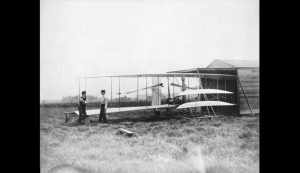 The author actually weighs in on the controversial and seemingly lasting debate of who was and what constitutes “First in Flight”, beyond what he says about the Smithsonian giving Langley’s “aerodrome the aforementioned endorsement of “First in Flight”, irrespective of German glider enthusiast Otto Lilienthal’s flights in 1894 and 1896, with the latter resulting in his death. McCullough does indicate that unprecedented photographs of the man deemed as the daring “Flying Man” and his gliders appeared the world over.
The author actually weighs in on the controversial and seemingly lasting debate of who was and what constitutes “First in Flight”, beyond what he says about the Smithsonian giving Langley’s “aerodrome the aforementioned endorsement of “First in Flight”, irrespective of German glider enthusiast Otto Lilienthal’s flights in 1894 and 1896, with the latter resulting in his death. McCullough does indicate that unprecedented photographs of the man deemed as the daring “Flying Man” and his gliders appeared the world over.
McCullough goes on to state regarding “First in Flight”: “Of further aggravation were stories of others who had supposedly achieved flight before the Wrights, the most annoying being that of a German American named Gustave Whitehead, who was said to have flown a plane of his own creation in Connecticut in 1901 and 1902. The story was entirely without evidence and wholly untrue, but kept drawing attention as the years passed to the point where Orville finally felt obliged to denounce it himself. In an article titled, ‘The Mythical Whitehead Flight,’ published in U.S. Air Services in 1945, he made plain that Whitehead was a man of delusions. Strangely, the story still draws attention, despite the fact that there is no proof.” Perhaps McCullough has not read Susan Brinchman’s Gustave Whitehead: First in Flight.
This is a tremendous book, with so many stories and subplots, along with numerous historic photos and illustrations to accentuate a bygone era that has catapulted us into modern aviation and space exploration. The CBS interview of McCulloch says it all here.
 Dennis Moore is the Associate Editor of the East County Magazine in San Diego and the book review editor for SDWriteway, an online newsletter for writers in San Diego that has partnered with the East County Magazine, as well as a freelance contributor to EURweb based out of Los Angeles. Mr. Moore can be contacted at contractsagency@gmail.com or you can follow him on Twitter at: @DennisMoore8.
Dennis Moore is the Associate Editor of the East County Magazine in San Diego and the book review editor for SDWriteway, an online newsletter for writers in San Diego that has partnered with the East County Magazine, as well as a freelance contributor to EURweb based out of Los Angeles. Mr. Moore can be contacted at contractsagency@gmail.com or you can follow him on Twitter at: @DennisMoore8.








Comments
The Wright Brothers, reviewed by Dennis Moore
The Wright Brothers - Gustave Whitehead: First in Flight
Thank you KB, although the Wright Brothers are given all the credit for being the "First in Flight", a lot can be said of Gustave Whitehead and his achievements, as chronicled by Susan Brinchman in her book: "Gustave Whitehead: First in Flight."
Fool me once...
The Wright Brothers, by David McCullough
First Flight! Dennis Moore review
David McCullough